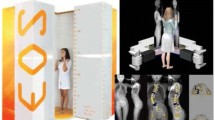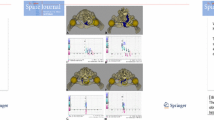Abstract
We studied the brace effect on the spinal profile in idiopathic scoliosis, using a MR procedure visualising the complete scoliotic spine in any vertical plane, while rotating it 180° on the longitudinal axis of the patient. Thirty-eight female patients (mean age, 14.5 years) were included in the study. Inclusion criteria were an idiopathic scoliosis, a Cobb angle greater than 20°, age of 10–17 years and bracing with a Chêneau brace. The brace effect was studied in 38 thoracic curves. The MR examinations were carried out in direct sequences, with and without brace. A reconstruction algorithm allows visualising the whole spine in vertical projections, with rotational steps of 2°, from −90° to 90°, referred to as MR animation. In various vertical MR projections, the changes of the curves were evaluated by measuring the Cobb angle. Additionally, a translation angle of the apical vertebra was determined, representing the lateral deviation of the apical vertebra from a defined midline. Testing the reproducibility of the Cobb angles, the standard deviation of the intra-individual differences was 1.7° and of the inter-individual differences, 2.1°. For the translation angles, the standard deviation of the intra-individual differences was 0.8° and of the inter-individual differences, 0.9°. With brace the mean Cobb angle of the thoracic curves was significantly reduced in the various vertical MR projections. The mean translation angle was also reduced. MR analysis showed that the brace effect is a translation process, straightening the profile of the scoliotic spine in all vertical planes. MR animation allows visualising the brace effect on the spine in scoliosis based on a 3D data set, without additional radiation exposure. It showed the straightening effect of the brace leading to a flattening of the sagittal spinal profile.




Similar content being viewed by others
References
Dickson RA, Weinstein SL (1999) Bracing (and screening)—yes or no? J Bone Joint Surg Br 81:193–198
Do T, Fras C, Burke S, Widmann RF, Rawlins B, Boachie-Adjei O (2001) Clinical value of routine preoperative magnetic resonance imaging in adolescent idiopathic scoliosis. A prospective study of three hundred and twenty-seven patients. J Bone Joint Surg Am 83:577–579
du Peloux J, Fauchet R, Faucon B, Stagnara P (1965) The plan of choice for the radiologic examination of kyphoscolioses. Rev Chir Orthop Reparatrice Appar Mot 51:517–524
Hausmann ON, Boni T, Pfirrmann CW, Curt A, Min K (2003) Preoperative radiological and electrophysiological evaluation in 100 adolescent idiopathic scoliosis patients. Eur Spine J 12:501–506
Konig R, Jaeger U, Ostertun B, Kandyba J, Wagner U, Gieseke J, Schild HH (1999) MR whole-spine recording: computer-assisted simulation of the conventional X-ray technique. Rofo Fortschr Geb Rontgenstr Neuen Bildgeb Verfahr 170:258–261
Korovessis P, Kyrkos C, Piperos G, Soucacos PN (2000) Effects of thoracolumbosacral orthosis on spinal deformities, trunk asymmetry and frontal lower rib cage in adolescent idiopathic scoliosis. Spine 25:2064–2071
Labelle H, Dansereau J, Bellefleur C, Poitras B (1996) Three-dimensional effect of the Boston brace on the thoracic spine and rib cage. Spine 21:59-64
Perie D, Sales De Gauzy J, Sevely A, Hobatho MC (2001) In vivo geometrical evaluation of Chêneau-Toulouse-Munster brace effect on scoliotic spine using MRI method. Clin Biomech (Bristol, Avon) 16:129–137
Pruijs JE, Hageman MA, Keessen W, van der Meer R, van Wieringen JC (1994) Variation in Cobb angle measurements in scoliosis. Skeletal Radiol 23:517–520
Schmitz A, Jaeger UE, Koenig R, Kandyba J, Wagner UA, Giesecke J, Schmitt O (2001) A new MRI technique for imaging scoliosis in the sagittal plane. Eur Spine J 10:114–117
Torell G, Nachemson A, Haderspeck-Grib K, Schultz A (1985) Standing and supine Cobb measures in girls with idiopathic scoliosis. Spine 10:425–427
Author information
Authors and Affiliations
Corresponding author
Rights and permissions
About this article
Cite this article
Schmitz, A., König, R., Kandyba, J. et al. Visualisation of the brace effect on the spinal profile in idiopathic scoliosis. Eur Spine J 14, 138–143 (2005). https://doi.org/10.1007/s00586-004-0788-z
Received:
Accepted:
Published:
Issue Date:
DOI: https://doi.org/10.1007/s00586-004-0788-z




